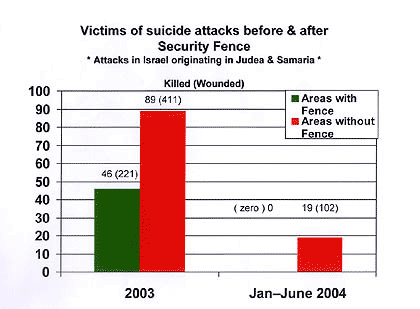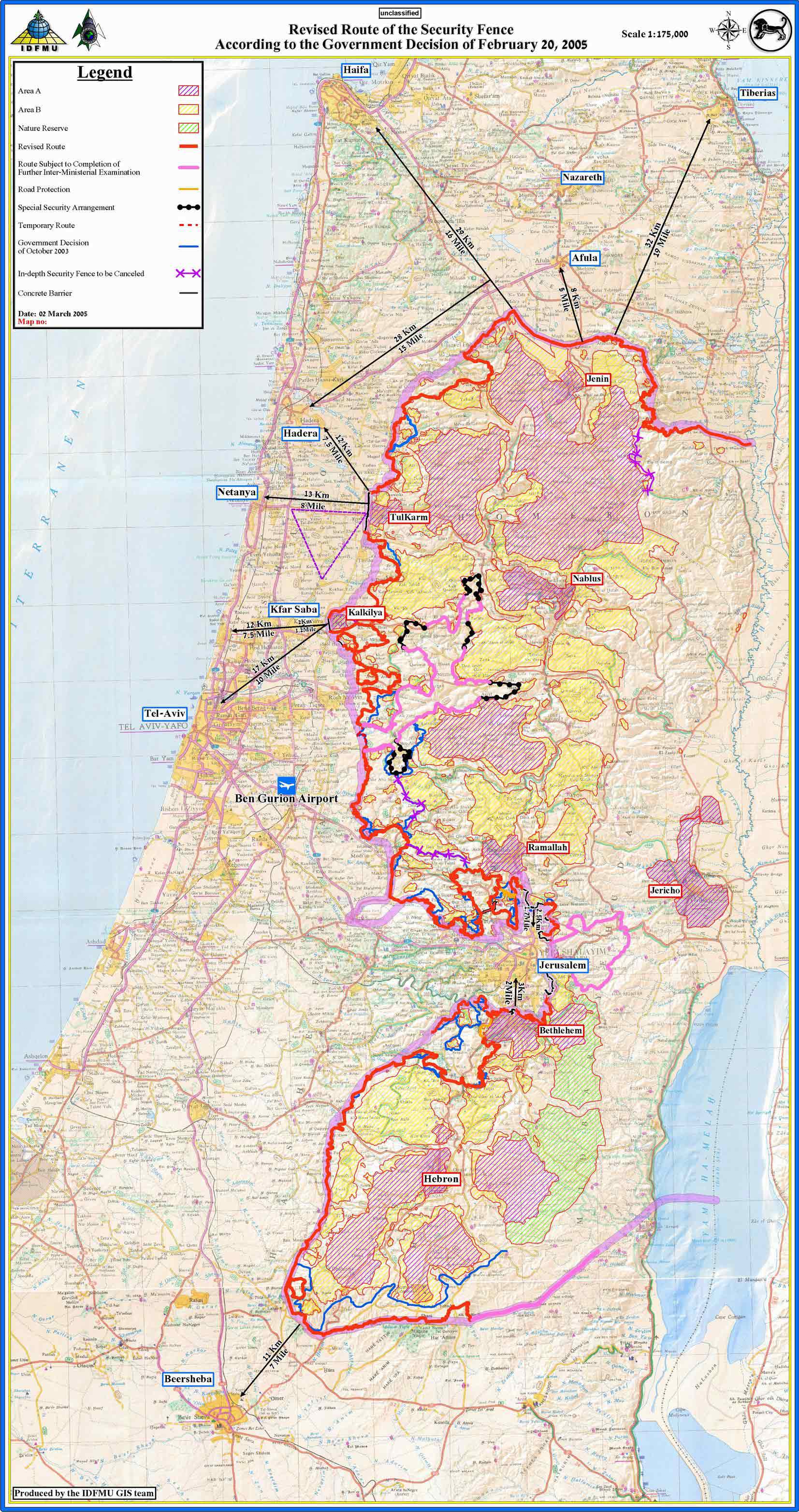Background & Overview
by Mitchell Bard
(Updated February 2016)
From September 2000 to mid-2005, hundreds of Palestinian suicide bombings and terrorist attacks against Israeli civilians killed more nearly 1,000 innocent people
and wounded thousands of others. In response, Israel's
government decided to construct a security
fence that would run near the “Green
Line” between Israel and
the West Bank to prevent Palestinian
terrorists from easily infiltrating into Israel proper. The
project had the overwhelming support of the Israeli public and was deemed legal by Israel's Supreme Court.
Israel's fence garnered international condemnation, but the outrage is a clear double standard - there is nothing new about the construction
of a security fence. Many nations have fences to protect their
borders - the United States, for example, has one to prevent illegal immigration. In fact, when the West Bank fence was approved, Israel had already built a fence surrounding the Gaza
Strip that had worked - not a single suicide
bomber has managed to cross Israel's border with Gaza.
- Israel is Forced to Act
- Making Terrorism More Difficult
- Other Benefits
- Planning the Fence Route
- High Tech Fence
- Politics
- Precedents
- Inconvenience vs Saving Lives
- 2016 Security Fence
Israel is Forced to Act
The
Palestinians committed themselves in the Oslo
accords and in the road map to dismantle terrorist networks and confiscate illegal weapons. After
more than 10 years of negotiations, and a mounting toll of Israeli civilian
casualties, however, it became clear to the Israeli people that the Palestinian Authority (PA) made
a strategic choice to use terror to achieve its aims and that something
had to be done to protect the civilian population.
“It obliges us to establish a barrier wall which
is the only thing that can minimize the infiltration of these male and
female suicide bombers,” said Defense Minister Benjamin Ben-Eliezer,
who has emphasized that “the fence is not political, [and] is not
a border.”
Some Israelis oppose the fence either because they
fear it will constitute a recognition of the 1949 armistice line as
a final border. Jews living in the West Bank, beyond the planned route
of the fence, in particular, argue that they are now being left relatively
unprotected and worry that they might be forced to relocate behind the
fence if it does become a political border in the future.
Making Terrorism
More Difficult
Before the construction of the fence, and in many places
where it has not yet been completed, a terrorist need only walk across
an invisible line to cross from the West Bank into Israel. No barriers
of any kind exist, so it is easy to see how a barrier, no matter how
imperfect, won't at least make the terrorists' job more difficult. Approximately
75 percent ofthe suicide bombers who attacked targets inside Israel
came from across the border where the first phase of the fence was built.
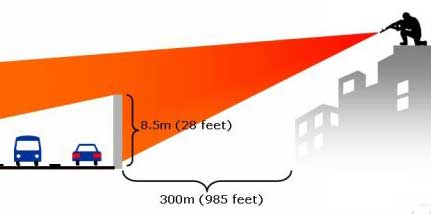 This diagram shows why a wall is being built in
a few specific places where Palestinian snipers have terrorized motorists.
This diagram shows why a wall is being built in
a few specific places where Palestinian snipers have terrorized motorists. |
During the 34 months from the beginning of the violence
in September 2000 until the construction of the first continuous segment
of the security fence at the end of July 2003, Samaria-based terrorists
carried out 73 attacks in which 293 Israelis were killed and 1950 wounded.
In the 11 months between the erection of the first segment at the beginning
of August 2003 and the end of June 2004, only three attacks were successful,
and all three occurred in the first half of 2003.
Since construction of the fence began, the number of attacks has declined
by more than 90%. The number of Israelis murdered and wounded has decreased
by more than 70% and 85%, respectively, after erection of the fence.
Even the Palestinian terrorists
have addmitted the fence is a deterrent.
On November 11, 2006, Islamic
Jihad leader Abdallah Ramadan
Shalah said on Al-Manar
TV the terrorist
organizations had every intention of continuing suicide
bombing attacks, but that their
timing and the possibility of implementing
them from the West
Bank depended
on other factors. “For example,” he
said, “there is the separation fence,
which is an obstacle to the resistance, and
if it were not there the situation would
be entirely different.”
The value of the fence in saving lives is evident from the data: In 2002, the year before construction started, 457 Israelis were murdered; in 2009, 8 Israelis were killed.
In order to thwart possible Hezbollah infiltrations through the border with Lebanon, in April 2015 it was announced that the IDF had begun construction of a 7-mile long land berm (earth barrier) on the Northern border. The IDF is “executing a significant engineering endeavor, creating obstacles in the terrain so as to use if for our defense” by constructing the border, according to IDF Colonel Alon Mendes. The barrier is expected to be expanded in the future.
Other Benefits
The Green Line is crossed by numerous dirt roads and it is impossible to patrol it.
Many Palestinians take advantage of these roads to come to work illegally
in Israel or to get between parts of the Palestinian administered territories
to avoid checkpoints. Some also cross to carry out terror operations
and theft. Since 1994, Palestinians, sometimes in cooperation with Israeli
middlemen, have stolen thousands of automobiles as well as farm machinery
and animals.1
Israelis living along the Green
Line, both Jews and Arabs, favor the fence to prevent infiltration
by suicide bombers and by thieves and vandals. In fact, the fence has
caused a revolution in the daily life of some Israeli Arab towns because
it has brought quiet, which has allowed a significant upsurge in economic
activity.
The Palestinians in the territories will also benefit
from the fence because it will reduce the need for Israeli military
operations in the territories, and the deployment of troops in Palestinian
towns. Onerous security measures, such as curfews and checkpoints, will
either be unnecessary or dramatically scaled back.
Planning the Route
The route of the fence must take into account topography,
population density, and threat assessment of each area. The fence is
scheduled to be built in stages. Phase A of construction, approximately
85 miles from Salem to Elkana was completed at the end of July 2003.
Phase B, which is about 50 miles, runs from Salem toward Bet- Shean,
through the Jezreel Valley and the Gilboa mountains. It was completed
in 2004.
Phase C of construction
incorporates Jerusalem.
During the “al-Aqsa intifada,” more
than 30 suicide bombings have targeted Jerusalem.
A total of 90 terrorist attacks have killed
170 people and injured 1,500 in the capital.
The original “Jerusalem Defense Plan” approved
in March 2003 called for the fence to be
constructed around three parts of the capital,
which has been the most frequent target
of suicide
bombers. This section of the fence
was expected to run about 40 miles around
the municipal boundaries of the city. Israeli
and Palestinian residents in areas along
the fence route filed legal challenges
that required changes in the construction
plan. In March 2005, Israel announced
it would build a temporary fence separating Jerusalem from the West
Bank by July,
leaving the structure in place while legal
challenges to the permanent barrier are
decided by the courts.
The updated route
is to run about 32 miles around Jerusalem,
but was only 25 percent complete in July
2005. The fence along the southern rim,
encircling neighborhoods such as Har
Homa and Gilo is mostly complete. The
northern section that will incorporate Pisgat
Zeev and Neveh Ya'acov began more recently.
The government originally set September 1,
2005, as the deadline for completing the
Jerusalem barrier, but shortly after this
decision, the Interior Minister said it could
not be finished before December or January.
As of August 2008, nearly one-third of the
fence — about 30 miles of
the approximately 100 mile fence — remained
unfinished. The principal impediment to finishing
the job has been a shortage of funds, however,
about 2 miles of the fence has also been
held up
by ongoing legal appeals.
Phase D will span approximately
93 miles from Elkana to Ofer. In addition,
several special sections of the fence will
protect specific areas and populations.
An inside fence of 15 miles will protect
the road from the airport to Jerusalem.
A fence around the town of Ariel will stretch
about 35 miles and a 31 mile section will
traverse the road between Ariel and Kedumim.
A 32-mile span will go from Jerusalem to Gush
Etzion,
another 19 miles will surround Gush Etzion
(incorporating 10 settlements and approximately
50,000 Israelis), and the fence
will continue an additional 58 miles to Carmel.
The planned route was approximately 458 miles; however,
the plan has been repeatedly modified and, in February 2004, the government
announced its intention to shorten the route and move the barrier closer
to the 1949 armistice line to make it less burdensome to the Palestinians
and address U.S. concerns. The announced changes included the dismantling
of a small stretch of fence east of Kalkilya to make movement easier
for residents going into the West Bank. The government cancelled plans
to build deep trenches to protect Ben-Gurion Airport and Route 443 from
Modi'in to Jerusalem because of concern about the impact on the Palestinians
in the area.
In February 2005, the route
was again modified to take into account
the decision by the Israeli Supreme
Court to take greater account of the impact of
the fence on the Palestinians. The proposed
route runs closer to the Green
Line than the original plan approved
in October 2003. For the first time, however,
the fence will include Ma'aleh Adumim and
the surrounding settlements.
To the east of the town, a “ring road” will connect the northern and southern parts
of the West
Bank,
allowing Palestinians to travel between Jenin
and Hebron.
The route of the fence in the Gush
Etzion region was altered to exclude
four Palestinian villages whose residents
will have free access to Bethlehem.
A special protective wall will be built along
Route 60 that links Gush
Etzion with Jerusalem.
The route of the fence in the Hebron Hills,
which originally included several settlements and
a large expanse of land beyond the Green
Line, has been brought close to the Green
Line. This new route will include 7
percent of the West
Bank on its “Israeli” side — as
opposed to 16 percent in the original
plan — and
approximately 10,000 Palestinian residents.
One of the most controversial questions has been whether
to build the fence around Ariel, a town of approximately 20,000 people,
the second largest Jewish settlement in the territories. To incorporate Ariel, the fence would have to extend
approximately 12 miles into the West
Bank. The United States has opposed the inclusion of Ariel inside
the fence. In the short-run, Israel decided to build a fence around
Ariel, but said in February 2005 it would be incoporated within the
main fence at a later stage.
As a result of the modifications,
the length of the barrier is expected to
be approximately 500 miles. As of July 2010,
only about 320 miles (64%) of the barrier
was completed
and much of the rest was tied
up by petitions to the Israeli Supreme
Court and Justice Ministry deliberations.
Work
is now being done on mostly constructed sections
of the fence and areas that have to be rerouted
in response to court
rulings. The Defense Ministry previously projected
the fence would be completed by 2010,
but now it does not give an end date.
The secruity fence is
the largest infrastructure project in Israel's
history. The cost of the project has ballooned
from an
expected $1 billion to more than $2.1 billion.
Each kilometer of fence costs approximately
$2 million.
Israeli Prime Minister Ariel Sharon has said that
the “fence is not a political border, it is not a security border,
but rather another means to assist in the war on terror.” As such,
Israel has repeatedly stated its willingness to move or remove the fence
as part of a Palestinian-Israeli peace agreement.
In the past, Israel has been willing to move fences,
even elaborate and expensive ones such as this security barrier. Along
the border with Lebanon, where
a high-tech fence equipped with surveillance cameras and sensors closely
monitors the situation, Israel has moved sections of fence more than
a dozen times in order to implement its U.N.-certified
withdrawal from Lebanon.
Israel has maintained that the security fence will
be an obstacle to terrorism, but not to an agreement with the Palestinians.
“I do not believe that the routing of the fence can prevent a
real accord,” said Finance Minister Benjamin
Netanyahu. “A fence can always be moved.”
A High-Tech Fence
Although
critics have sought to portray the security
fence as a kind of "Berlin
Wall," it is nothing of the sort. First,
unlike the Berlin Wall, the fence does not
separate one people, Germans from Germans,
and deny freedom to those on one side. Israel's
security fence separates two peoples, Israelis
and Palestinians, and offers freedom and
security for both. Second, while Israelis
are fully prepared to live with Palestinians,
and 20 percent of the Israeli population is already Arab, it is the Palestinians who
say they do not want to live with any Jews
and call for the West Bank to be judenrein.
Third, the fence is not being constructed
to prevent the citizens of one state from
escaping; it is designed solely to keep terrorists
out of Israel. Finally, only a tiny fraction
of the total length of the barrier (less
than 3% or about 10 miles) is actually a
30 foot high concrete wall, and that is being
built in three areas where it will prevent
Palestinian snipers from around the terrorist
hotbeds of Kalkilya and Tul Karm from shooting
at cars as they have done for the last three
years along the Trans-Israel Highway, one
of the country's main roads. The wall also
takes up less space than the other barriers,
only about seven feet, so it did not have
a great impact on the area where it was built.
Most of the barrier will be a chain-link type fence
similar to those used all over the United States combined with underground
and long-range sensors, unmanned aerial vehicles, trenches, landmines
and guard paths. Manned checkpoints will constitute the only way to
travel back and forth through the fence. The barrier is altogether about
160 feet wide in most places.
The land used in building the security fence is seized
for military purposes, not confiscated, and it remains the property
of the owner. Legal procedures are already in place to allow every owner
to file an objection to the seizure of their land. Moreover, property
owners are offered compensation for the use of their land and for any
damage to their trees.
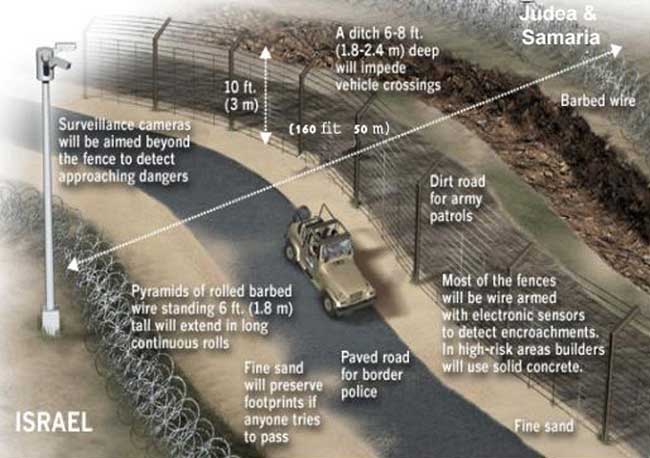
Politics
The construction of the fence has been slowed by political
divisions over the precise route. The most controversial aspects of
the project are decisions regarding the inclusion of Jewish settlements.
Israel wants to include as many Jews within the fence, and as few Palestinians
as possible. To incorporate some of the larger settlements, however,
it would be necessary to build the fence with bulges inside the West
Bank. The Bush Administration understands Israel's security arguments
regarding the need for the fence, but does not want it to prejudge negotiations
or to threaten the possibility of creating a contiguous Palestinian
state and therefore has pressured Israel to restrict construction to
the area along the pre-1967 border, or as close as possible to it. The
so-called “Green Line,”
however, was not an internationally recognized border, it ws an armistice
line between Israel and Jordan pending the negotiation of a final border.
Building the fence along that line would have been a political statement
and would not accomplish the principal goal of the barrier, namely,
the prevention of terror.
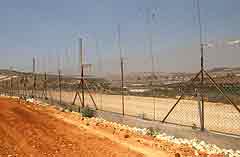 |
Most
of the fence runs roughly along the Green
Line. The fence is about a mile to the east in three places that
allows the incorporation of the settlements of Henanit, Shaked, Rehan,
Salit, and Zofim. The most significant deviation from the 1967 line
is a bulge of less than four miles around the towns of Alfei Menashe
and Elkanah where about 8,000 Jews live. In some places, the fence is
actually inside the “Green
Line.”
The fence especially complicates
potential negotiations related to Jerusalem as
it will make it more difficult to devise
a compromise that would lead to a division
of the city, an idea that is unpopular with
Israelis. Since the fence is not permanent,
it is possible that it could be relocated,
or become unnecessary if a peace agreement
were reached, in which case a political settlement
could be reached.
In the meantime, an estimated
55,000 Jerusalem Arabs from four neighborhoods
are expected to be on the Palestinian side
of the fence while 180,000 Arab residents
of the city remain on the Israeli side
of the barrier. Over the past year, thousands
of Arab have moved to more central East
Jerusalem neighborhoods to stay on the Israeli
side of the fence. Representatives of some
Arab neighborhoods have gone so far as to
petition the Israeli Supreme
Court to order the Defense Ministry
to reroute the fence so it runs to the
east of the neighborhoods of Anata, Ras
Hamis and Shuafat and allows them to be
on the Israeli side. To alleviate the inconvenience
caused by the fence, the Cabinet approved a plan
to construct 11 passages through the barrier
to facilitate movement in and out of
the city. In addition, the government is
allocating NIS 8 million for the municipality
to provide special services to Arab residents
of Jerusalem who will be adversely affected
by the fence.
Palestinians complain that the fence creates “facts
on the ground,” but most of the area incorporated within the fence
is expected to be part of Israel in any peace agreement with the Palestinians.
Israeli negotiators have always envisioned the future border to be the
1967 frontier with modifications to minimize the security risk to Israel
and maximize the number of Jews living within the State. When the Palestinians
stop the violence and negotiate in good faith, it may be possible to
remove the fence, move it, or open it in a way that offers freedom of
movement. Israel, for example, moved a similar fence when it withdrew
from southern Lebanon. The
fence may stimulate the Palestinians to take action against the terrorists
because the barrier has shown them there is a price to pay for sponsoring
terrorism.
Precedents
It is not unreasonable or
unusual to build a fence for security purposes.
Israel already has fences along the frontiers
with Lebanon, Syria,
and Jordan,
so building a barrier to separate Israel
from the Palestinian Authority is
not revolutionary. Most nations have fences
to protect their borders and several use
barriers in political disputes:
- The United States
is building a fence to keep out illegal
Mexican immigrants.
- Spain built a fence,
with European Union funding, to separate
its enclaves of Ceuta and Melilla from
Morocco to prevent poor people from sub-Saharan
Africa from entering Europe.
- India constructed
a 460-mile barrier in Kashmir to halt
infiltrations supported by Pakistan.
- Saudi
Arabia built a 60-mile barrier
along an undefined border zone with Yemen to
halt arms smuggling of
weaponry and announced plans
in 2006 to build a 500-mile fence along
its border with Iraq.
- Turkey built a barrier
in the southern province of Alexandretta,
which was formerly in Syria and is an
area that Syria claims as its own.
- In Cyprus, the UN
sponsored a security fence reinforcing
the island’s de facto partition.
- British-built barriers
separate Catholic and Protestant neighborhoods
in Belfast
Ironically, after condemning
Israel’s barrier, the UN announced plans
to build its own fence to improve security
around its New York headquarters.
Inconvenience
Versus Saving Lives
Every effort is being made
to exclude Palestinian villages from the
area within the fence and no territories
are being annexed. The land used in building
the security fence is seized for military
purposes, not confiscated, and it remains
the property of the owner. Legal procedures
are already in place to allow every owner
to file an objection to the seizure of their
land. In addition, Israel has budgeted $540
million to ease
the lives of Palestinians affected
by the fence by building extra roads, passageways,
and tunnels.
Israel is doing its best
to minimize the negative impact on Palestinians
in the area of construction and has created
70 agricultural passageways to allow farmers
to continue to cultivate their lands, and
crossing points to allow the movement of
people and the transfer of goods. Moreover,
property owners are offered compensation
for the use of their land and for any damage
to their trees. Contractors are responsible
for carefully uprooting and replanting the
trees. So far, more than 60,000 olive trees
have been relocated in accordance with this
procedure. In addition, the government
has spent NIS 2 billion to construct
an alternative system of roads, underpasses
and tunnels to facilitate Palestinian travel
around the barrier.
Additionally, the
Civil Administration in Judea and Samaria opened a District Coordinating
Office (DCO) in December 2004, to assist Palestinians living in
the Jerusalem area affected
by the construction of the fence.
Operations of this office will focus on assisting the 110,000 Palestinians
living in Abu Dis and Eizariya, in the areas east of Jerusalem and Kalandiya,
A Ram and Bir Naballah to the north. The office will deal with issues concerning education, religion,
employment, humanitarian assistance and will coordinate entry of Palestinians
into Jerusalem.
Despite Israel's best efforts, the fence
has caused some injury to residents near
the fence. Israel’s Supreme
Court took up the grievances of Palestinians and ruled that
the construction of the security fence is
consistent with international law and was
based on Israel’s security requirements
rather than political considerations. It
also required the government to move the
fence in the area near Jerusalem to make things easier for the Palestinians.
Though the Court’s
decision made the government’s
job of securing the population from terrorist
threats more difficult, costly, and time-consuming,
the Prime Minister immediately accepted
the decision and began to reroute the fence
and to factor the Court’s
ruling into the planning of the rest of the
barrier.
Palestinians continue to
challenge the route of the fence and the
Court has issued a number of decisions, some
favoring the existing route and others, the
petitioners. For example, in June
2006, the Court ordered Israel to
tear down a two-mile stretch of fence around
Zufin, a settlement near the West
Bank town of Kalkilya
and reroute it to accommodate Palestinians
in the area. In July 2008, the government
responded to another court decision and agreed
to move part of the barrier that was on the
land of the residents of the village of Bil’in.
The security fence does create some inconvenience to
Palestinians, but it also saves lives. The deaths of Israelis caused
by terror are permanent and irreversible whereas the hardships faced
by the Palestinians are temporary and reversible.
2016 Security Fence
Israeli Prime Minister Netanyahu unveiled a proposal to surround Israel with a security fence in February 2016, stating that Israel needed to protect itself from Palestinian and terrorist infiltration. The Prime Minister received criticism from world leaders as he referred to citizens of Israel's neighboring countries as well as Palestinians as "wild beasts." Netanyahu described the border project as a multi-year plan to surround all of Israel with security fences. The Prime Minister made the announcement while visiting a newly constructed fence between Israel and Jordan in February 2016, and also said that the Israeli government would be looking to permanently fix gaps in the current seperation wall. Education Minister Naftali Bennett expressed disdain for Netanyahu's proposal, explaining “the prime minister spoke today about how fences are needed. We are wrapping ourselves in fences. In Australia and New Jersey there is no need for fences.”
Following months of daily lone-wolf terror attacks dubbed by Palestinian leadership as the “Days of rage,” Israeli officials announced that Israel would fill in gaps in the separation barrier in Jerusalem, and complete the barrier in Tarkumiya. Some Palestinians who participated in the late-2015, early-2016 wave of violence used gaps in the security fences to enter Israel illegally without proper permits.
Sources:Near
East Report, (July 15, 2002; July
28, 2003);
Jerusalem Report, (September 8,
2003, December 7, 2005,
July 10, 2007; July 28, 2008);
Ha'aretz,
(February 25, 2004);
Israeli
Foreign Ministry;
Ministry
of Defense;
B'tselem, (January 15,
2006);
Miller, Elhanan. “Land berm going up on Lebanon border to thwart Hezbollah,” Times of Israel(April 15, 2015);
Beaumont, Peter.
“Netanyahu plans fence around Israel to protect it from 'wild beasts',” The Gaurdian (February 10, 2016);
Ravid, Barak. “After Terror Attacks, Israel to Complete Separation Barrier Construction Around Jerusalem, Southern West Bank,” Haaretz, (March 9, 2016);
Color maps courtesy of MidEast
Web
1MidEast
Web
2JTA,
(June 18, 2003).
|

